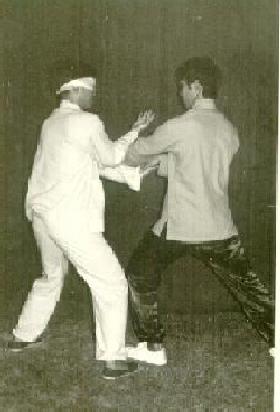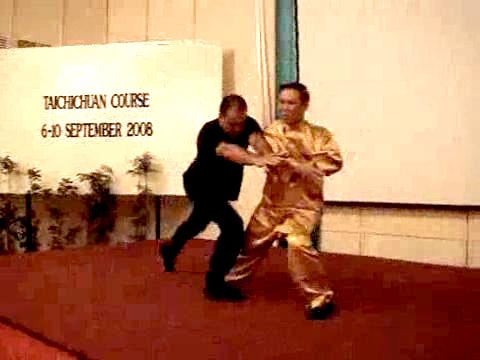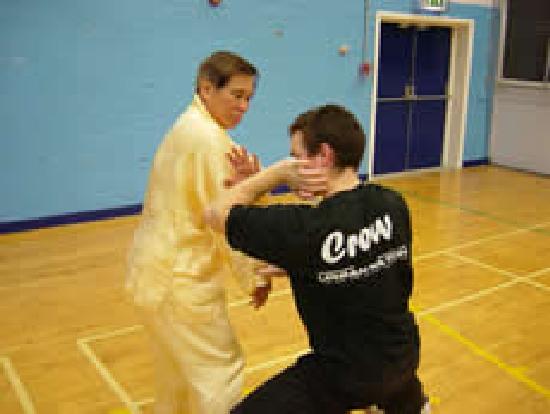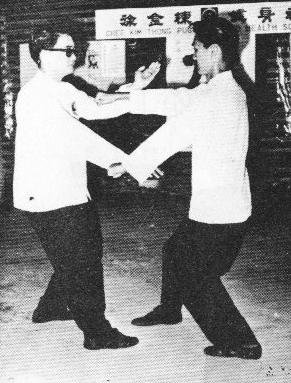June 2009 (Part 2)
SELECTION OF QUESTIONS AND ANSWERS

“Grndamster Wong and Sifu Koay practicing Wing Choon "Chi Sau" or "Sticking Hands"
Question 1
I have been exploring -
- Chi Sao - Wing Choon
- Push Hands - Tai Chi Chuan
- Asking Bridges - Hoong Ka
- Kneading Hands - Wuzu
— Sifu Jamie Robson, Scotland
Answer
Yours are very interesting questions. They will not only enhance our practice but also contribute to the preservation of important kungfu philosophy.
Indeed I was lucky to have practiced "Asking Bridge" from Uncle Righteousness and Sifu Ho Fatt Nam, "Sticking Hands" from Sifu Choe Hoong Choy, and "Kneading Hands" from Sifu Chee Kim Thong. Not many students today have such opportunities. At first I could not see any connections among them. But later I discovered some very important relationships.
As you know, I did not learn Taijiquan formally from any teachers, so I did not learn "Pushing Hands" formally too. I observed how Taijiquan exponents practice "Pushing Hands" and I read whatever literature I could get on it.
There is very little information in books about "Pushing Hands". All that is available is just a few pictures showing two exponents doing "Pushing Hands", and to many people these different pictures look alike.
Yet, interestingly, this little information told me a lot about "Pushing Hands". I suddenly realized that the onus of "Pushing Hands" was not to learn techniques, but to develop skills. The pictures looked alike though the descriptions were different because they illustrated skills, which were "invisible", and not just showed forms, which most people saw at the surface.
For example, in one picture in a Taijiquan book on "Pushing Hands". you may see two exponents with their right forearms in contact and a caption below saying "peng" or ward off. In another picture where the two opponents are in a similar pose but the caption below says "li" or press forward. Many people would be puzzled, and wonder why the same pose is termed "peng" in one instance and termed "li" in another.
This reminds me of a Shaolin classic on the Shaolin Five Animals I read many years ago. Almost all the pictures that showed the different Shaolin Animals were similar. Yet, some were meant for Dragon, some for Snake, others for Tiger, for Leopard and for Crane. At that time I was puzzled. I expected to see different forms for different Animals.
Do you know why? The answer for both the Taijiquan "Pushing Hands" and the Shaolin Five Animals is the same. The pictures show the outward form, which may be the same. It is the inner essence that differentiates between "peng" and "li", and between Dragon, Snake, Tiger, Leopard or Crane from other Animals.
Hence, the outward form of our Wahnam Taijiquan "Pushing Hands" is very simple. We purposely reduce our attack movements to only one technique, "Open Window to Look at the Moon", and also our defence movements to only one technique, "Immortal Waves Sleeves", so as to focus on the inner essence.
This has worked very well for us. For example, after learning "Pushing Hands" from me only once at an Intensive Taijiquan Course, Robin went home to practice it on other masters at a Taijiquan conference. He could easily beat all of them at Pushing Hands, including some famous masters. A few of the masters even became very angry!
Question 2
Perhaps, not surprisingly, I have discovered many similarities. I'm trying to work out the best methodology to train, and perhaps in the long-term teach to my 10 senior students.
Answer
Because of the effectiveness of our "Pushing Hands" in Wahnam Taijiquan, some Shaolin instructors have asked me whether we could introduce a similar programme in our Shaolin training.
In principle, it is good to have a similar programme, but in practice our existing Shaolin programme is already so full that adding it may overburden the training. Moreover, the nature of Shaolin combat is quite different from that of Taijiquan. Introducing "Pushing Hands" may "soften" our Shaolin Kungfu, which aready is "soft" compared with the Shaolin Kungfu most other schools practice. Of course, "soft" does not imply any lack of force.
Nevertheless, I am still considering the suggestion. If we introduce a similar programme it will most likely be based on "Asking Bridge" from Hoong Ka Kungfu.

Grandmaster Wong rotates his waist to avoid a powerful push from Sifu Piti during Taijiquan "Pushing Hands"
Question 3
I came across this quote of yours in an old Q & A - "I mentioned the lineage in my unpublished manuscript on Wing Choon Kungfu written many years ago."
I wonder if this manuscript still exists. Do you have any advice in constructing a suitable methodology for developing such skills?
Answer
Yes, I still have this Wing Choon manuscript, though right now I do not remember where I have placed it. It was written before the advent of the personal computer. So it is not in digital format but as typed manuscript.
In constructing a methodology to develop such skills, it is necessary to ensure that the skills and the techniques involved are conducive to the art, and not distracting from it. While skills are generally transferable, a straight-forward borrowing of skills and techniques from another art may sometimes be detrimental if their combat philosophies are different.
This, in fact, is very common nowadays. Many kungfu practitioners borrow the skills and techniques of Western Boxing. While this borrowing may enable them to fight better compared to when they could not fight at all, it kills the essence of their kungfu. While the difference among the various kungfu styles is not as much as that between kungfu and Boxing, there is still some difference.
The following is an example of "Asking Bridge" in Hoong Ka Kungfu. Two students, A and B, face each other in their Bow-Arrow Stance with their right Tiger-Claws in contact. A presses down B's Tiger-Claw and executes a palm strike. B deflects the attack with a Mirror-Hand and counters with another palm strike. A "leans" his Tiger-Claw on B's attacking arm.
You would notice that Hoong Ka "Asking Bridge" is different from Taijiquan "Pushing Hands", Wuzu "Kneading Hands" and Wing Choon "Sticking Hands". This is because they have different combat philosophies.
During my recent visit to Japan, Emiko, who learned Wing Choon from her uncle from a famous lineage, asked whether I would teach Wing Choon, and I agreed to teach a comprehensive Wing Choon course as a supplement to our regular Shaolin Kungfu, in line with our Shaolin Tantui taught two years ago, and Eagle Claw to be taught at UK Summer Camp this year to introduce our students to other great kungfu styles. This Wing Choon course will probably be held in Toronto in spring next year.
The basis of the course will be Siu Lin Tao, the fundamental Wing Choon set. Besides explaining the combat applications of the patterns in the set, I shall also show how it can be used to develop internal force.
Wing Choon Chi Sau, or Sticking Hands, will also be taught. When I leaned Chi Sau from the Patriarch of Choe Family Wing Choon, Sifu Choe Hoong Choy, it was "formless", i.e. it did not consist of fixed patterns. Like Asking Bridges and Kneading Hands that I leaned from my other sifus, it was meant to develop combat skills rather than learn fighting techniques.
But I shall stylize the Chi Sau movements into routine forms. This will not only enable course participants to attain combat skills more systematically in much shorter time, but also enable them to apply Wing Choon techniques in combat.
Question 4
So far, I have combined all I know about the four listed above, and have been calling it 'Bridging Forces'. Your help would be deeply appreciated.
Answer
Although "Asking Bridge", "Sticking Hands" and "Kneading Hands" are not formally taught in our Shaolin programme, some of their skills and techniques are found in our basic Shaolin combat sequences.
The link between "Fierce Tiger" and "Black Tiger" at the start of Combat Sequence 5, for example, is from Hoong Ka "Asking Bridge". Sinking the bridge to defend against "Dark Dragon Draws Water" in Combat Sequence 6, and countering with "Dark Dragon Enters a Well" are from Wing Choon "Sticking Hands".
The subsequence defence to float the attack following its momentum, using "Golden Dragon Plays with Water", before counter-attacking with a "Precious Duck", is from the "float principle" of Wuzu "Kneading Hands". Our Shaolin skills and techniques, just seen from the examples here, are extremely rich.
An important piece of advice in your composing the movements for "Bridging Forces" is to let the movements flow and develop naturally, and not artificially put pre-conceived techniques in. You can then refine the movements and stylize them. Show me your composition when there is an opportunity, and I shall offer further advice.

Grandmaster Wong and Sifu Ronan applying Hoong Ka "Men Kiu" or "Asking Bridge" in an application of the set "Fierce Tiger Descends Mountain"
Question 5
Sometimes I have gone into deep trances unintentionally from a waking state. My eyes are open and everything around me looks as if it has been colored golden. One night this happened and I looked at my hand and arm, and I was shocked that they looked like corrupted flesh.
Would you be willing to provide some insight on what I was experiencing when my vision was changed?
— Shawn, USA
Answer
A possibility that in your deep trance your hand and arm looked like corrupted flesh was your conscious or unconscious thought.
Thoughts are reality. What you will be are due to three factors, namely your thoughts, your speech and your actions in that order of importance. It is therefore very important that you must have good thoughts all the time, for yourself as well as for other people.
You should do the following exercise daily for 5 days. When you are at Standing Meditation after performing "Lifting the Sky" about 15 times, have a gentle thought that good cosmic energy is flowing through your arms and hands and nourishing them. Feel that your whole body is charged with golden light, and you are full of vitality.
Question 6
As you know I work with a lot of difficult patients in a psychiatric hospital who generally have been unwell for a long time.
I have noticed that while many make very good progress initially some will progress for a while and then seem to come to a halt. It seems to be a blockage that almost seems to want to keep them stuck or unwell. Sometimes they are aware of this but often will just seem to get worse without feeling they are contributing. They will "forget" to practice beneficial things or arrive at appointments. This seems different to those who deliberately set out to sabotage themselves.
Could you suggest any Chinese medicine/chi kung healing approaches for working with such patients when this phenomenon arises?
— Barry, UK
Answer
The problem you mentioned is common, to patients with psychiatric as well as physical problems, though most of them do not know it and often their doctors or healers may not realize it.
That is a main reason for the Chinese medical tenet that all healing starts from the heart. That was why during the Chi Kung Healing Course I emphasized that the healer must first and foremost convince his patients that they (1) wanted to and (2) could get well. Teaching or prescribing the theroapeutics is only the thrid action after these two.
This tenet is even more important with psychiatric patients. You need to find out what their fears and aspirations are, and then work on them productively.
If a patient is afraid that she may lose her husbabd to another woman, do not tell her that she is afraid to lose her husband, which is true but by telling her you confirm her fear and may strengthen it. But tell her that if she is fearful and nervous most of the time, she may end up losing her husband to another woman.
Before this thought sinks in, immediately tell her that she can overcome this problem if she wants to. Emphasizes if she really wants to.
Don't rush to teach her the therapeutics. Only after ensuring that she really wants to overcome her fear, and is convinced that with your help she can do it, should you teach her the remedial exercises.
This is one main reason why our fees are high. If you charge her 50 pounds, she is likely to regard your treatment as one of many other treatments she would try as a routine and then give up for another. If you charge her 500 pounds it is most likely she wants to get well and is convinced that you can help her. Seen in this context, charging 50 pounds is expensive, and you have wasted her time. Charging 500 is cheap and she will be happy to pay it.
She is also likely to continue to practice what you have taught her, not because of the 500 pounts but because she does not want to lose her husband. Also tell her to dress attractively and be nice to her husband, without implying that she is not attractive. You would then not only help her to overcome her psychatric problem but also bring happiness to her family.
I would like to post your question and my answer in my Q-A series as it will help many instructors, like giving them confidence to charge high fees and assuring prospective students or patients that they will get much more than what they pay for. But if you have any reservations about this, please let me know.

Two disciples of Grandmaster Chee Kim Thong practicing Wuzu "Cai Sau" or "Kneading Hands", taken from http://www.shareapic.net/content.php?id=10685148&owner=eric88ling
Question 7
My relationship with my family has improved significantly. In the past, because they didn't agree with my desire to study Chinese medicine I used to believe my family stood in the way of my personal and spiritual goals and fought with them constantly. Now though we've finally reached the point where I no longer see them as enemies and I ask them for advice and guidance on how to proceed with what I wish to do.
— Ray, USA
Answer
I am very glad that now you realize that even when you disagree with your parents, you know they mean well. This is a natural progress from your diligent practice of our arts. Be kind to your parents and spend time with them.
Question 8
During my practice I reached a point where I was able to understand the senses as empty and during my day to day life would try and observe the mind as it moved from one sense to another. However I reached a point where I became very confused and could no longer just observe my wandering mind but ended up getting lost again in frustrations and desires.
To deal with this I've been practicing constant prayer and good thoughts to God throughout the day. I would very much like to reach the point where I can function in the world but be "empty" and unattached. Where I know I am here but not here at the same time. Could Sifu provide any advice on how to do so?
Answer
Unless you have decided to cultivate to return to God, like what monks do, and certainly you are not at this stage of development yet, there is no need to practice special meditation exercises like what you have done. You also need not practice constant prayer. This is meant for monks.
Just carry on practicing our arts the way you have learnt from me. Follow the three golden rules of practice, namely don't worry, don't intellectualize, and enjoy your practice.
If you just do this, you will have abundant energy and attain clarity of mind, with which you will get better results no matter what you do. At your present stage of development, you should do well in your work and enjoy yourself wholesomely with your girlfriends.
LINKS
Selected Reading
- Cultural Meanings of Sifu Wong Chun Nga's Wedding Ceremonies
- The Blessing and Responsibility of Being a Husband and Father
- Chi Channelling
- Flowing Water Floating Clouds
- Fierce Tiger Descends Mountain
